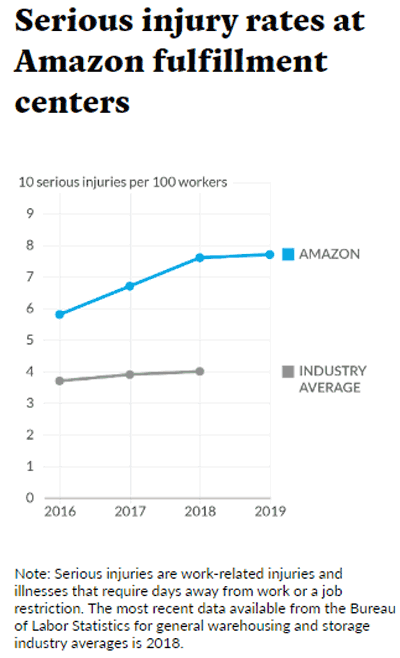A report at the end of September from a group called Reveal: the Center for Investigative Reporting alleges that Amazon has worker injuries at its fulfillment centers well above industry benchmarks.
The left-leaning organization says that it was able to get access to internal Amazon safety reports and weekly injury numbers from its nationwide network of fulfillment centers.
Supply Chain Digest Says... |
|
|
Those reports "reveal a mounting injury crisis at Amazon warehouses, one that is especially acute at robotic facilities and during Prime week and the holiday peak," the study claims.
It further alleges Amazon's injury rates have risen each of the past four years, based on the internal data. In 2019, Amazon fulfillment centers recorded 14,000 serious injuries – those requiring days off or job restrictions. Reveal says Amazon's overall rate of 7.7 serious injuries per 100 employees was 33% higher in 2019 than in 2016 – a rate nearly double the most recent industry standard. (See graphic below.)
Reveal adds that "The data back up the accounts of Amazon warehouse workers and former safety professionals who say the company has used the robots to ratchet up production quotas to the point that humans can't keep up without hurting themselves."
The report also says that for each of the past four years, injury rates at Amazon have been significantly higher at Amazon's robotic warehouses than at its traditional sites. Why would that be?
The report suggests it is the result of workers at the more robotic fulfillment centers being expected to pick up and scan roughly 400 items an hour, compared with the standard rate of 100 items per hour at other facilities. That could be leading to injuries related to fatigue, the report says.
At the most common type of Amazon fulfillment center, those that ship small- and medium-sized SKUs, the rate of serious injuries from 2016 to 2019 was more than 50% higher at warehouses with mobile robots than ones without, the investigation claims.
Reveal also alleges that Amazon may also be underreporting warehouse worker injuries.

Source: Reveal
Amazon said in a statement that it "strongly refutes the claims" that it misled the public on its workplace injury rates. The company also disputed Reveal's characterization of "serious injuries," which under OSHA reporting can include almost anything, Amazon said.
In May, Amazon CEO Jeff Bezos told shareholders that "Nothing is more important than the health and well-being of our employees.
(See More Below)
|
CATEGORY SPONSOR: SOFTEON |
|
|
| |
|
|
Reveal also says Amazon has tried to reverse the injury trend.
Monthly bulletins from Amazon's environment, health and safety team show that the famously data-obsessed company is well aware of its safety problems" Reveal says. "Each month, company officials sent out detailed updates – marked "Privileged & Confidential" – to warehouse safety managers across the country with data, charts and FAQs. They set safety goals and monitor progress closely."
However, Reveal says tut the internal documents show that the company has failed to hit these targets. In 2018, Amazon planned to lower the injury rate by 20%. Instead, injury rates went up. The next year, the goal was more modest: a 5% decrease. But the rate rose again, Reveal claims.
Reveal's investigation also found that in June 2019, the monthly report from the Amazon safety director in charge of robotic warehouses across the country was frank about the risks.
It noted that FCs in the region that encompasses New Jersey, New York, Maryland and Connecticut were "expecting an increase in injuries across all sites during Prime Week." Injuries already had increased in the ramp-up to Prime Day that year, a trend the report attributed to mandatory overtime and bringing in 1,200 to 2,000 seasonal employees to each robotic site in that region. Both the overtime and the influx of new workers were labeled "high-risk situations."
Prime Week 2020 has just started, after being delayed from June due to the virus pandemic.
The report says that Amazon started a pilot project, outlined in a May 2019 report, seeking to lower injuries by not off the highest and lowest shelves on pick faces, "optimizing work allocation to an associate's power zone," so workers wouldn't have to bend as low or reach as high.
According to the report, ergonomic issues such as excessive repetition and bending down led to 74% of injuries among the workers.
That pilot project, however, was designed for use only "during non-Peak" seasons. And out of six FCs involved in the pilot, five put it on hold for the runup to Prime Day. The report warned there was "risk of complete termination of (the) project."
Reveal says that Amazon declined to provide an update on the program's current status.
There is much more in the full report, which is available here: How Amazon hid its safety crisis
Any reaction to this story on Amazon injuries? Do you blame the pace of the work? Let us know your thoughts at the Feedback section below.
|